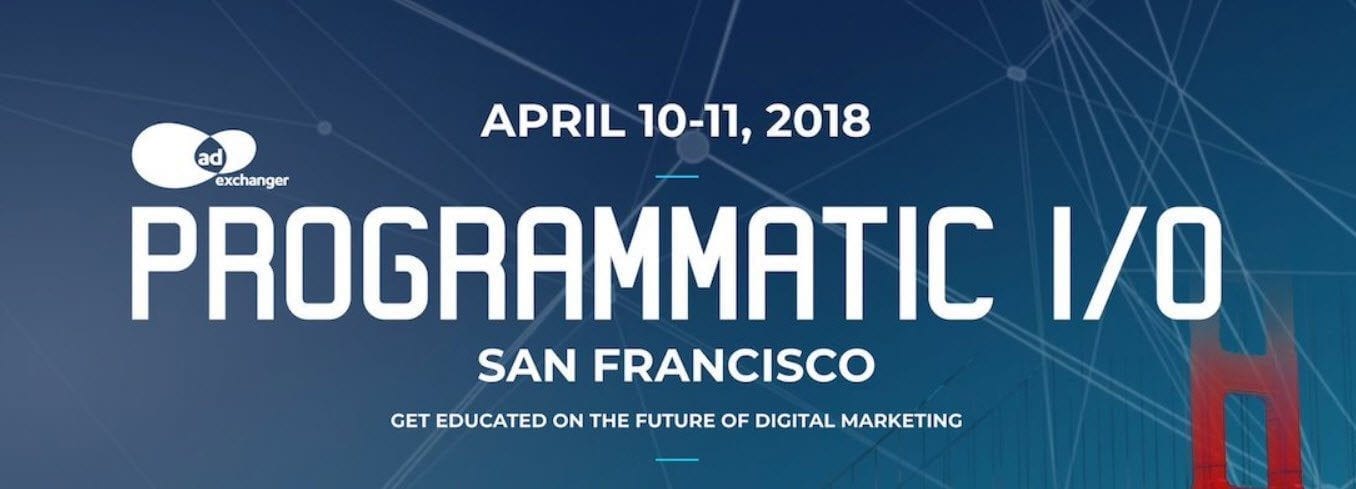AdExchanger’s Programmatic I/O is the world’s largest gathering of the data-driven marketing ecosystem. It is a semi-annual event, and this time around, was held in San Francisco on April 10th and 11th, as nearly 3000 professionals and experts shared stories and insights about their experiences with programmatic media and advertising, from both the buyer and seller-side of the equation.
Conversations spanned many topics related to programmatic, taking in-depth looks at data management platforms (DMP), transparency, third-party data, programmatic in-housing, as well as other trending topics like Facebook and artificial intelligence.
Among the speakers, were members of Meredith, The New York Post, REI, Pandora, Spotify, Essence, Oath, 360i, Live Nation, IPG Mediabrands, Condé Nast, GroupM, Vox, The New York Times, Facebook, Uber, Google, and much, much more. Members of MediaRadar were also in attendance to discuss the current and future state of programmatic media and advertising.
Let’s take a look at MediaRadar’s three takeaways from April’s Programmatic I/O:
1. The quality of third-party data needs to improve.
The spotlight has been shone on the state of third-party data in recent weeks, mostly due to Facebook’s move to disallow third-party data providers from offering targeting directly on their platform – a direct reaction to the troubles they encountered with political data firm, Cambridge Analytica.
Many speakers at the event iterated the idea that third-party data is not dead, however, it simply needs to improve. “Third-party data is here to stay – if it’s high-quality,” said Alice Lincoln, VP of Data Policy and Governance at MediaMath.
The problem with third-party targeting has typically been its lack of cleanliness. Alice Lincoln and Patrick Sayler, CEO of Gigya, discussed examples of how they’ve been misrepresented in the third-party data ecosystem by very inaccurate data, to which Sayler added, “The brands we’re working with are realizing that a direct digital connection with consumers is extremely important. In fact, it’s a differentiator.”
It’s also important to mention that the General Data Protection Regulation (GDPR) becomes enforceable in May of 2018. And while that does mean that brands will be looking to bolster their first-party data, the fact of that matter is, most brands cannot live entriely on first-party data. They’ll still need to harness third-party data to supplement their ad strategies.
The GDPR will help move third-party partnership in the right direction, not eradicate it. Third-party data is most likely here to stay, but certainly needs to improve.
2. In-housing programmatic is hard work.
Uber, Ubisoft, and Bayer served as the three most prevalent examples of programmatic in-housing. They all shared stories of how their recent in-housing efforts have evolved.
Bennett Rosenblatt, Head of Programmatic Display for Uber, discussed some of Uber’s realizations since taking things in-house.
Rosenblatt first talked about Uber’s “two-way street” agency relationship. While they use an agency for brand awareness campaigns, they execute their mobile strategy themselves. In the process of doing so, they teach their agency a bit about how their mobile strategy works, while the agency teaches them how to run efficient brand awareness campaigns.
It took some time for Uber to build this type of agency partnership, however. Rosenblatt stated that Uber’s biggest regret in their in-housing efforts was, “being too skeptical of agency partnerships and waiting too long to bring them in.” He went on to say that the negativity that some feel towards agencies is generally not true, and that Uber should have been more open towards agency partnerships.
The main realization Uber has had since bringing their efforts in-house, is that it’s really hard work.
Agencies are becoming more transparent with their pricing models, and Uber now realizes how much work it is just to do that – from paperwork, to harnessing buying power and maintaining ad-server relationships.
“The 5-10% agency fees really aren’t that bad,” in Uber’s eyes, after seeing how much work it takes to build an in-house team. Ultimately, Uber has learned that there is a lot more to bringing media buying in-house then simply buying media.
3. China’s mobile shopping boom could be a sign of things to come for the US.
“Singles Day” is China’s equivalent to what Black Friday and Cyber Monday are in the US – a day for immense retail sales in a typically slow part of the year.
Singles Day takes place on November 11th (11/11), and was originally meant to be a day where people celebrate being single. Over time, however, it has become a major retail event run by Alibaba, the e-commerce and internet retail mogul.
In 2017, Singles Day saw an incredible $25.3 billion in sales – a 40% increase from the year prior. Amazingly, Alibaba’s one-day sales doubled that of Cyber Monday and Black Friday combined in 2017.
The discussion at Programmatic I/O was not merely about Singles Day sales, however, but more so about mobile sales. Perhaps the most notable part of the $25 billion in sales was that 90% of those sales took place on mobile – about $22.5 billion. In the month of November, the average individual in China spent 3 hours shopping on mobile, where as the average American spent only 56 total minutes shopping on mobile.
While Singles Day 2017 was an incredible feat on its own, it is also a potential sign of things to come for US mobile shopping.
On Cyber Monday in 2017, the US saw $6.59 billion in sales, $2 billion of which took place on mobile, putting mobile sales at about 33%. This is a minuscule number compared to China, but shows substantial room for growth.
If the gap between mobile and total sales shrinks substantially in the US , then mobile opportunities will sky rocket for advertisers, meaning the US mobile ad market could become an enormous source of opportunity come November of 2018 and beyond.





